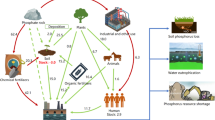Abstract
An evaluation was made of the annual productivity of Spirulina (Arthrospira) and its ability to remove nutrients in outdoor raceways treating anaerobic effluents from pig wastewater under tropical conditions. The study was based at a pilot plant at La Mancha beach, State of Veracruz, Mexico. Batch or semi-continuous cultures were established at different seasons during four consecutive years. The protein content of the harvested biomass and the N and P removal from the ponds were also evaluated. Anaerobic effluents from digested pig waste were added in a proportion of 2% (v/v) to untreated sea-water diluted 1:4 with fresh water supplemented with 2 g L−1 sodium bicarbonate, at days 0, 3 and 5. A straight filament strain of Spirulina adapted to grow in this complex medium was utilized. A pH value 9.5 ± 0.2 was maintained. The productivity of batch cultures during summer 1998 was significantly more with a pond depth of 0.10 m than with a depth 0.065 m. The average productivity of semi-continuous cultures during summer 1999 was 14.4 g m−2 d−1 with a pond depth of 0.15 m and 15.1 g m−2 d−1 with a depth of 0.20 m. The average annual productivity for semi-continuous cultures operating with depths of 0.10 m for winter and 0.15 and 0.25 m for the rest of the year, was 11.8 g m−2 d−1. This is the highest value reported for a Spirulina cultivation system utilising sea-water. The average protein content of the semi-continuous cultures was 48.9% ash-free dry weight. NH4-N removal was in the range 84–96% and P removal in the range of 72–87%, depending on the depth of the culture and the season.
Similar content being viewed by others
References
APHA 1998. Standard Methods for the Examination of Water and Wastewater. 20th edn. American Public Health Association, Washington, DC, USA, 2-58.
Ciferri O. 1983. Spirulina, the edible microorganism. Microbiol. Rev. 47: 551-578.
Becker E.W. 1994. Microalgae: Biotechnology and Microbiology. Cambridge University Press Cambridge, UK.
Belay A., Ota Y., Miyakawa K. and Shimamatsu H. 1993. Current knowledge on potential heath benefits of Spirulina. J. appl. Phycol. 5: 235-241.
FAOSTAT 1998., http://apps.fao.org.
García J., Mujeriego R. and Hernández-Mariné M. 2000. High rate algal pond operating strategies for urban wastewater nitrogen removal. J. appl. Phycol. 12: 331-339.
Hach Company 1995. Procedures Manual., 525-526.
Hernández E. and Olguín E.J. 2002. Biosorption of heavy metals influenced by the chemical composition of Spirulina sp. (Arthrospira) biomass. Environ. Technol. 23: 1369-1377.
Laliberté G., Olguín E.J. and de la Noue J. 1997. Mass cultivation and wastewater treatment using Spirulina. In: Vonshak A. (ed.), Spirulina platensis - Physiology. Cell-Biology and Biotechnology, Taylor and Francis, London, UK, pp. 159-173.
Lu C. and Vonshak A. 1999. Photoinhibition in outdoor Spirulina platensis cultures assessed by polyphasic chlorophyll fluorescence transients. J. appl. Phycol. 11: 355-359.
Machado M., Sánchez N. and Olguín E.J. 1996. Recycling of fish processing effluents with recovery of Arthrospira maxima. 7th Proc. Internat. Conference ISAB., South Africa, 16-19 April, pp. 50.
Márquez F.J., Nishio N. and Nagai S. 1995. Enhancement of biomass and pigment production during growth of Spirulina platensis in mixotrophic culture. J. Chem. Tech. Biotechnol. 62: 159-164.
Márquez F.J., Sasaqui K., Kakizono T., Nishio N. and Nagai S. 1993. Growth characteristics of Spirulina platensis in mixotrophic and heterotrophic conditions. J. Ferment. Bioengng 75: 408-410.
Mohn F.N. 1988. Harvesting of micro-algal biomass. In: Borowitzka M.A. and Borowitzka L.J. (eds), Micro-Algal Biotechnology. Cambridge University Press, Cambridge, p 395.
Olguín E.J. 1996. Opportunities for environmental biotechnology within the current context of the mexican agroindustry. In: Galindo E. (ed.), Fronteras en Biotecnología y Bioingeniería. SMMB, México, pp. 309-316.
Olguín E.J. 2000. The cleaner production strategy applied to animal production. In: Olguín E.J., Sánchez G. and Hernández E. (eds), Environmental Biotechnology and Cleaner Bioprocesses. Taylor and Francis, London, pp. 227-243.
Olguín E.J., Galicia S., Angulo-Guerrero O. and Hernández E. 2001. The effect of low light flux and nitrogen deficiency on the chemical composition of Spirulina sp. (Arthrospira) grown on pig waste. Bioresour. Technol. 77: 19-24.
Olguín E.J., Galicia S., Camacho R., Mercado G. and Pérez T.J. 1997. Production of Spirulina sp. in seawater supplemented with anaerobic effluents in outdoor raceways under temperate climatic conditions. Appl. microbiol. Biotechnol. 48: 242-247.
Olguín E.J., Hernández B., Araus A., Ramírez M.E., Camacho R., Galicia S. et al. 1994. Simultaneous high biomass protein production and nutrient removal using Spirulina maxima in seawater supplemented with anaerobic effluent. World J. microbiol. Biotechnol. 10: 576-578.
Olguín E.J. and Vigueras J. 1981. Unconventional food production at the village level in a desert area of Mexico. In: Proc 2nd World Congress of Chemical Engineering., Montreal, Canada, pp. 332-335.
Oswald W.J. 1991. Introduction to advanced integrated wastewater ponding systems. Wat. Sci. Tech. 24: 1-7.
Sweeten J.M. 1992. Livestock and poultry waste management: a national overview. In: Blake J., Donald J. and Magette W. (eds), National Livestock, Poultry and Aquaculture Waste Management. Proceedings of the National Workshop 29-31 July 1991, ASAE publication 03-92.
Tredici M., Papuzzo T. and Tomaselli L. 1986. Outdoor mass culture of Spirulina maxima in sea-water. Appl. microbiol. Biotechnol. 24: 47-50.
Vonshak A., Chanawongse L., Bunnag B. and Tanticharoen M. 1996. Light acclimation and photoinhibition in three Spirulina platensis (cyanobacteria) isolates. J. appl. Phycol. 8: 119-124.
Vonshak A. and Guy R. 1992. Photoadaptation, photoinhibition and productivity in the blue-green alga, Spirulina platensis grown outdoors. Plant Cell Environ. 15: 613-616.
Wu B., Tseng C.K. and Xiang W. 1993. Large-scale cultivation of Spirulina in sea-water based cultured medium. Bot. mar. 36: 99-102.
Zarrouk C. 1966. Contribution á l'étude d' une cyanophycée. In-fluence de divers facteurs physiques et chimiques sur la croissance et la photosynthèse de Spirulina maxima (Sech. et Gardner) Geitler. Thèse de Doctorat d'Etat, Université de Paris, France.
Author information
Authors and Affiliations
Rights and permissions
About this article
Cite this article
Olguín, E.J., Galicia, S., Mercado, G. et al. Annual productivity of Spirulina (Arthrospira) and nutrient removal in a pig wastewater recycling process under tropical conditions. Journal of Applied Phycology 15, 249–257 (2003). https://doi.org/10.1023/A:1023856702544
Issue Date:
DOI: https://doi.org/10.1023/A:1023856702544




